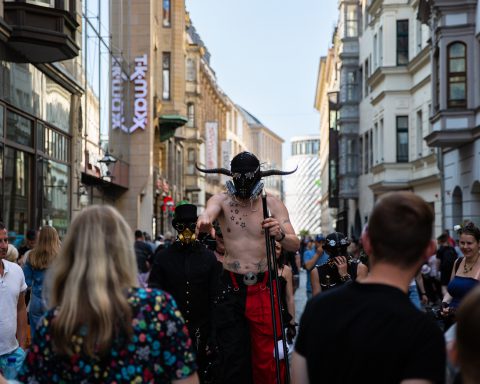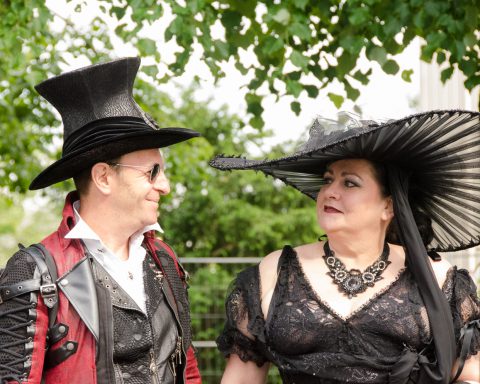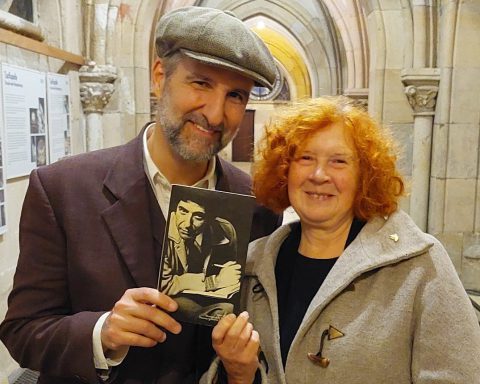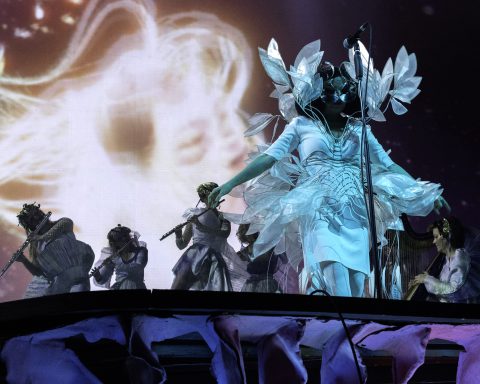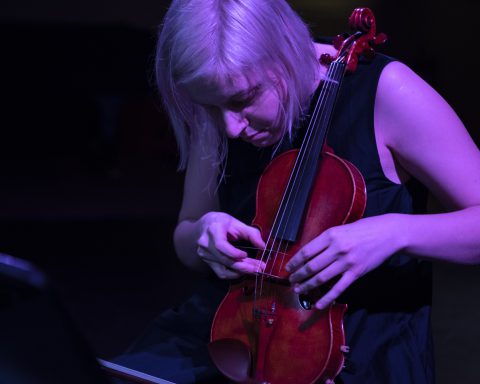Leipzig’s introduction to Drifter sounds like the echoes of Fever Dreams that chime all the way down the hallway to the reception area, through which your correspondent lately enters.
Martin Sandström’s twelve-string electric guitar can be heard starting up like an old clockwork engine ringing arpeggios, coming to life. The metronome tub-thump of a programmed kick drum comes in. The bass arrives. A rhythm builds, the music walks, and Staffan John Sigvard sings a lonely monorhyme prayer that becomes consumed and is lost under the music’s layers to fade out.
The shiny and recently-refurbished Haus Leipzig is a big stage for the three Stockholm-based Swedes. There is capacity on the floor for thousands, but a shrunken crowd present of only a hundred or so.
Also, the space on stage is vast enough to accommodate the kind of corporate egos and good-time hire bands that normally play at this venue; and thankfully Drifter aren’t that kind of band.
Neither do they appear entirely comfortable with the theatricisms that a platform of this size demands.
Vocalist Staffan Sigvard remains partially concealed stage-right behind his synth for the duration. Patrik Engström on bass also hangs stationary in the shadows under an unbranded baseball cap.
It’s Martin Sandström on guitar who gamely eats up the limelight. He rocks his axe, gurning centre stage, clearly loving the chance to turn his Fender Twin up to nine, his distorted Marshall screaming on ten. His black denim jacket says Sonic Youth. He has eye make-up on, and blonde chest-length hair. A stage presence marked by the school of glamorous rock and roll.

—
Did you enjoy playing tonight?
Martin: It was a really good venue and I really liked the sound on stage, and everyone was super professional. It’s always nice to be welcomed in that way.
Staffan: I can only speak for myself, but I get kind of anxious when you walk into these kind of big venues. You’re thinking “Oh, I’m going to play here,” because we’re used to smaller places.
Martin: I guess we’re all sort of neurotic in our own ways – and self-analysing – but it was loads of fun to play here.
Staffan: Everything was great but also, in this place, everything was so polished. Was this built one year ago? You kind of get the feeling: “Can I touch this? Has the paint really dried?”
—
My own introduction to this band, Drifter, had come in the form of an international press release from the Wave-Gotik-Treffen.
Of course, the information inside contained mostly cold data about the festival weekend. But also included was a list of 28 under-the-radar bands that the WGT booking agent personally recommended that we, in the music press, might be interested in paying particular attention to:
“Occasionally one hears complaints that the WGT only books bands which have hardly any clicks on YouTube and are therefore not known by anyone.” They said of Drifter, “as long as they sound like this quasi-follow-up project of the guitar goddess Jeniferever, which is about to release its first record, what’s the problem? Is there something wrong with giving young bands a chance?”
As it turned out, Drifter already had self-released their first record, Moonstones, in November 2017, to little event or fanfare.
While middle-men in the music industry have never been less relevant to the process of making and distributing new records, the trouble that self-employed artists are experiencing right now is how to get their work in front of people without having the marketing experience and press contacts that record labels still provide.
That Moonstones can be found floating around the internet with only scraps of streams and downloads says more about that doomed scuffle for attention indie artists are facing than about the quality of the music itself – because from the first listen I was floored. Particularly by Martin Sandström’s guitar playing, which is a cornerstone of what makes Drifter’s music memorable.

His style is so far removed from the tired cliches of jazz and blues, and is so tastefully lilted by the great post-punk guitar players of the 1980s.
—
Martin: I love Sonic Youth, of course. The Cure is also a very big influence, but I also come from a big metal background. I loved a lot of metal music when I was a kid, and I played drums since I was 13 or something like that. But I never ever played in a pure metal band. It was always mixed with grunge or indie rock or something like that.
Name one grunge band and one indie band that were important to you.
Martin: Sonic Youth would be my favourite indie rock band, and I was about 11 when Nirvana released Nevermind. It blew me away. I realised this music was what I wanted to do.
So, that’s where I come from, but also I’m a guitar nerd so I like to make music that challenges myself, with lots of pedals. I think [my music] comes from all of these things. There is the saying less is more, and that’s fine – but I also think more is more!
—
Martin Sandström is not a kid. He’s 38 years old, and has been making music for 20 years. The majority of that time he’s spent with emo post-rock quartet Jeniferever, which had their commercial heyday in the late 2000s.
Staffan John Sigvard, who also comes from Uppsala, is six years Sandström’s junior.

At the time of Jeniferever’s zenith, Staffan was singing and playing rhythm guitar with local band We Are The Storm.
With my introduction to Sigvard’s work coming via Drifter, I was impressed by the variety of his vocal performances in the We Are The Storm back catalogue. Elastic wails and cerebral lyrics cutting loose over 4/4 Telecasters kind of sound like Bloc Party, but with a hardcore grit and edge.
The only surprising thing about Uppsala’s favoured guitar player and resident indie poet collaborating to make a goth-lite album together is that it took them almost a decade to do so.

—
Staffan: Me and Martin have been friends forever but we’d never done music together. We’d been talking about it forever, but we then started making music about two years ago. At first Drifter was just a duo. Patrik joined [on bass] 3 months ago.
Patrik: Yeah, this is my third show with this band.
Staffan: Me and Martin come from the same city and it’s kind of small, so we’d been doing shows together but with different bands. It’s a tiny city and all the musicians that do good things, they know each other
What brought the two of you together?
Staffan: I think we have the same thoughts about music. We both love The Cure, and that’s the foundation of a lot of stuff. But Martin also likes a lot of bands that I hate…
Martin: Likewise!
Staffan: But it’s also the drive to make music. [The shared feeling that music] is what we’re going to do now. We’re not going to do it once a week, we’re going to do this all the time. A lot of my friends that I’ve played with before, they’ve moved on to do something else.
—
The new addition of The Blue Tears’ Patrik Engström on bass is one that has yet to drastically change the band’s sound, but certainly including a live bass player in the writing process is something that will enhance Drifter going forward.

Moonstones had some great songs: the epic maudlin opening, “Fever Dreams” for one; the sick peace of “Leave All Men Behind“ another; and the new-romantic pop of “Just Visiting.“ However, in no world would Drifter’s melancholic rock opuses, “Rust“ and “Brook Horse,“ not be improved by the change of pace and color that a live rhythm section brings naturally.
Despite the gently affecting songwriting and the technical fireworks from Sandström’s guitar, the album as a whole was held back by basic beats and a lack of dynamics. Weaknesses that were made most clear on the longer songs that seemed to trudge on and overstay.
—
Staffan: The music we’re making is all live so we have to work within the limitations. I can only take away things or I can add things. I cannot change the rhythm.
What equipment do you have up there on your table?
Staffan: A Yamaha RX5. I really wanted to find that ‘80s snare. Sisters of Mercy, that kind of sound. We must have tried ten different drum machines.
Martin: I think they’re all still under my bed.
Was asking Patrik to join on bass part of a bigger plan to move towards all-human instrumentation?
Staffan: No, I don’t think so.
Martin: When we started making music, I felt that the most interesting part of it was that we were only going to be two people. It gets difficult with four or five people.
How has bringing Patrik into the band changed the way you make music?
Staffan: We tried it out and everything was perfect from the first chord.
Martin: Maybe not the first chord, but I remember the second rehearsal. I had this guitar line I wanted to try out and we just started making a song out of it, and I think it’s the best song that we’ve written so far.
Staffan: I think before Patrik, the music was more static. We wanted to move away from that, and Patrik’s a great bass player. Now our songs can have more dynamics.
Does that mean there is a sonic ideal or a vision that you are working towards?
Martin: No. I’ve never approached music in that way, having a set vision in mind. We don’t want to be trapped by any rules. I find a lot of bands at festivals like this are doing that. There are many good bands, but with others that I’ve seen it’s obvious that they just want to sound like Joy Division or make post-punk or new-wave music. Their ideas have not moved forward in 40 years.
Staffan: To me it seems unnecessary. That music is already existing.
Martin: We’re not saying that we’re totally original but we do try to find new ways to mix up what we do.
—

For now it would seem that their focus is on releasing new material.
The shape those releases will take, Martin shrugs and says it could be an EP or an album. They do not know yet. However, one thing the band are set on is including Leipzig in a European tour they are planning for this autumn.

